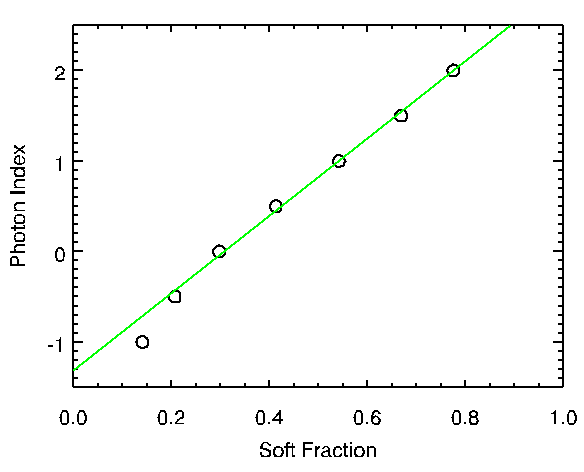BAT Hardness Ratio Estimates
BAT Cal Memo 2004-08-20
20 Aug 2004
C. Markwardt and D. Hullinger
BAT Hardness Ratio Estimates and Power Law Indices
Summary
A crude indicator of the hardness of the burst can be used to estimate
its spectrum, assuming it is close to a power law in the BAT band,
15-150 keV. Using the pre-launch response matrix, we find a simple
relation between hardness ratio and power law photon index:
gamma = -1.31 + 4.27 x (15-50 keV counts) / (50-350 keV counts)
[ where the photon spectrum is dN/dE = E^{-gamma}, and "counts" are
mask-weighted counts. ]
Details
The spectrum of a Gamma-Ray Burst can be estimated using a simple
hardness or softness ratio, computed as the ratio of counts in one
energy band to another band. While such a computation is not perfect,
it provides a quick and reasonably straightforward estimate of the
spectral slope.
For this brief study, we assume that the spectral shape is a power
law. This is a reasonable approximation given that at energies lower
than ~200 keV, the spectrum is consistent with a power law (Band et
al. 1993, 413, 281). However, there is typically a break to a steeper
index above a cut-off energy. Typically that cut-off is ~100-200 keV,
but may be lower.
We estimated the count rate for a range of power law photon indices,
in each of four energy bands: 15-25, 25-50, 50-100, 100-350 keV.
These energy bands correspond to the nominal bands reported in BAT
standard light curves and in the TDRSS light curves for gamma-ray
bursts. The estimates were done using XSPEC, with a response matrix
for an on-axis source, with the mask weighting technique. Here
negative photon indices describe an upward-sloping continuum.
The Figure shows a plot of the photon index as a function of the
soft fraction. The soft fraction is defined as the ratio of
counts, (15-50 keV) / (15-350 keV), which is the sum of the lower two
bands over the total band flux.

Figure. Power law photon index variations with soft fraction.
The Figure shows a nearly linear trend, except for extremely hard
spectra (photon indices < 0.5). As shown by Band et al. (1993), this
linearity range also matches the typical GRB photon indices. Thus,
for most bursts and sources with power law spectra, users will be able
to estimate the photon index by computing the simple ratio above.
The trend can be modeled as:
(photon index) = -1.31 + 4.27 x (soft fraction)
for photon indices steeper than -0.5, with a theoretical index error
of < 0.1. However, as this is a simulation, performed with a
pre-launch response matrix, and under certain circumstances, the
actual errors are likely to be larger. Finally, it's worth pointing
out that if the actual spectrum is not a power law, then the soft
fraction not be interpretable in terms of a photon index.
References
Band, D. et al. 1993, ApJ, 413, 281
Appendix
Raw simulated counts used in above plots and calculations.
; BAT Hardness ratio as a function of power law index
; Columns:
; (1) Power law index (gamma)
; (2-5) Counts in bands 15-25,25-50,50-100,100-350 keV
; Hypothetical 10ks exposure, mask weighted response
; D. Hullinger, 20 Aug 2004
-1.0 439435. 2.28262e+06 7.96390e+06 8.58642e+06
-0.5 78614.0 304140. 821432. 645631.
0.0 152929. 428736. 871712. 501948.
0.5 312717. 635995. 950196. 397016.
1.0 656967. 980151. 1.06059e+06 323047.
1.5 142079. 155904. 120393. 26759.0
2.0 311186. 253158. 140851. 22366.0
